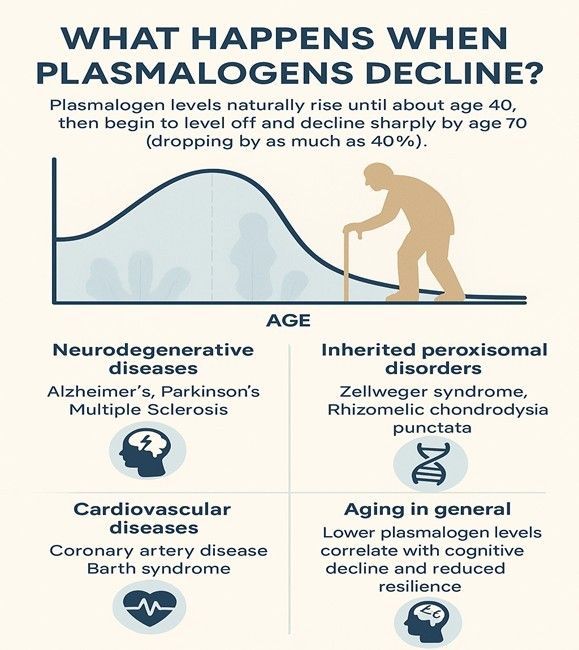From Decline to Resilience: How Plasmalogen Replacement Therapy Protects the Brain and Beyond
Plasmalogen Replacement Therapy: A New Frontier in Brain and Body Health
For decades, most medical research has focused on proteins and genes as the targets for therapy. But scientists are now uncovering another key player in human health: lipids. Among these, plasmalogens have emerged as one of the most important—and overlooked—molecules in protecting the brain, heart, and body.
Why Plasmalogens Are Essential
Plasmalogens aren’t just structural building blocks. They perform critical jobs in the body:
- Antioxidant Defense – Neutralize damaging free radicals and protect cells from oxidative stress
- Anti-Inflammatory Role – Help calm chronic inflammation
- Nerve Function – Support myelin (the protective insulation around nerves) and optimize communication between brain cells
- Cell Signaling – Influence pathways like MAPK/ERK and PI3K/AKT, which are involved in growth, repair, and survival
- Membrane Health – Keep cell membranes stable, flexible, and able to transmit signals
Recent research even shows that plasmalogens may influence ferroptosis—a type of cell death linked to uncontrolled lipid oxidation, which plays a role in cancer and neurodegeneration.

The Promise of Plasmalogen Replacement Therapy (PRT)
Because plasmalogens are so vital, researchers have developed a strategy called Plasmalogen Replacement Therapy (PRT). The goal is simple: restore plasmalogen levels in the body to improve health outcomes.
How It Works
- Natural sources like scallops, sea squirts, and chicken skin contain plasmalogens, but the amounts are too low for practical use.
- Synthetic precursors (such as alkylglycerols or specially designed plasmalogen analogs) are more effective because they can be taken orally, absorbed, and converted into plasmalogens in the body.
What Studies Show
- Cell studies – PRT increased plasmalogen levels, improved mitochondrial function, reduced inflammation, and protected neurons.
- Animal studies – PRT improved memory, reduced neuroinflammation, restored nerve conduction, and even slowed disease progression in models of Alzheimer’s, Parkinson’s, and cardiovascular disease.
- Human studies – Early trials show improvements in plasmalogen levels, cognitive performance, motor function, and metabolic markers in patients with dementia, Parkinson’s, and peroxisomal disorders.
The Future of PRT
While research is still early, the results are encouraging. Scientists are now exploring:
- Better delivery systems (like nanoparticles) to cross the blood-brain barrier
- Ways to target specific plasmalogen subtypes (for brain vs. heart health)
- Combining PRT with antioxidants for synergistic protection
PRT represents a modern, lipid-based approach to medicine—one that may finally address conditions with no effective treatments.
Key Takeaway
Plasmalogens are not just another nutrient. They are essential molecules that protect the brain, heart, and body at the cellular level. As levels decline with age and disease, Plasmalogen Replacement Therapy offers a groundbreaking strategy to restore resilience, protect cognition, and support long-term health.
The shift toward lipid-based therapies like PRT marks a new era in molecular medicine—one that holds real promise for patients with unmet medical needs.
Partner with Confidia Health Institute
At Confidia Health Institute, under the guidance of Dr. Kevin Greene, we recognize the critical role plasmalogens play in protecting the brain, heart, and body. With cutting-edge solutions like Plasmalogen Replacement Therapy (PRT)—including ProdromeNeuro™ and ProdromeGlia™—we help patients restore what aging and disease have taken away.
Our mission is to go beyond symptom management and address health at its cellular foundation, where resilience truly begins.
👉 Ready to protect your brain and body at the cellular level?
Contact Confidia Health Institute today to schedule a consultation with
Dr. Kevin Greene and discover how targeted plasmalogen support can help you safeguard memory, movement, and long-term vitality.
